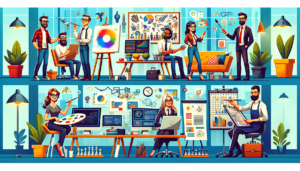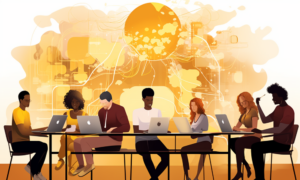-
Provided by

- Date published: Dec 6, 2023
- Categories
Whether it’s AI upskilling or neurodiversity education, delivering company-wide learning programs is no mean feat. Many global organizations have resorted to increasingly drastic measures for employee development (Slack, we’re looking at you.)
So, how is Societe Generale’s London-based team achieving measurable progress with a company-wide inclusion training program?
Ben Higgins, Managing Director and UK Head of HR at Societe Generale, joins HRD Connect to answer this question. He covers:
- Identifying and fixing gaps in inclusion in their London-based team
- Behaviour modelling and actor-based learning to deliver safe and impactful training
- Starting with ‘proof of concept’ groups before rapidly scaling to the full platform
1. What was missing from Societe Generale‘s approach to inclusion training?
Ben Higgins: Our renewed focus on inclusion was a natural evolution of our DEI journey. We were keen to decentralize inclusion training from being an HR topic. We wanted to increase accountability and engagement across the organization while educating leaders as critical catalysts of change.
We’re now on an ongoing journey using workshops with DEI Partners and our ’inclusion leaders’to gather outputs and learnings.For context, our ‘inclusion leaders’ are a group of approximately 100 leaders throughout different business and service divisions. We identified them for this work as champions of inclusion and key role models. Critically, they had proven ability to influence.
Here are the three most common themes from our workshops:
- Seeing greater diversity at senior levels and having visible role models.
- Considering all forms of diversity, going beyond gender diversity.
- Creating more informal opportunities to connect with others.
2. What change management fundamentals did you adopt to deliver inclusion training at scale?
Ben Higgins: Our HR team partnered with workplace culture and behaviour consultancy Byrne Dean to deliver the training across the organization.
Our UK Executive Committee was the first to receive the training in May last year. This was to check the ‘proof of concept’ landed well with them, which it did. Following this success, we started with HR Business Partners, followed by People Managers, and then the rest of the company.
It was important to have a blend of participants who were already DEI-savvy, alongside those who wanted to develop their awareness and knowledge.
3. How did behaviour models help develop understanding and examples for inclusion, authenticity, and microaggressions at work?
Ben Higgins: We used a multitude of behavioural models, in conjunction with two scenarios. One involved a work allocation decision, the other a micro-aggression.
Both scenarios were relatable and authentic within a workplace context. They were presented either by live actors or on video, enabling experiential learning. The models helped develop participants’ understanding of each scenario and guide their possible responses. Two of these models were particularly effective. These were:
- The ‘shadow’ focus and the impact your decision-making and behaviour can have on others.
- The Actor-Receiver-Observer language and the duty to proactively improve the environment we work in.
4. Why did you employ actor-based learning and can you outline how this worked in practice?
Ben Higgins: Actor-based learning has been helpful as it enables people to see realistic situations that can happen in the workplace.
Creating a ‘safe space’ is a prerequisite of this exercise. Leveraging actors is key to this and helps to facilitate group discussion. In practice, the actors performed inclusion role-plays from genuine stories. We then invited employees to participate and share as a group how they would respond to the dilemmas.
5. You built an online resource hub to support the inclusion training. How did you ensure the adoption of the platform?
Ben Higgins: Again, we collaborated with Byrne Dean to build an online learning platform. We segmented the content into easily digestible sections, using multimedia capabilities and interactive features. Participants could engage with the information in a variety of interesting and thought-provoking ways.
We also invited our leaders to attend a dedicated 90-minute preparation session where we demonstrated features like session outlines and insights into emotional intelligence. This covered how best to support others when discussing inclusion in the workplace.
6. What best practices would you recommend for other organizations delivering company-wide inclusion training?
Ben Higgins: Engaging every layer of the organization generated an organization-wide discussion. It reinforced the message that inclusion is a collective effort. That we are in this together.
Holding large group sessions to discuss these issues brought energy to the topics and helped to create momentum that other forms of training seldom do. When discussing shifting the culture of the firm, it helps to talk about day-to-day behaviours together.
We also used a relatively short timeline of a few months to get large volumes of people involved in the training; everyone experienced the sessions at a similar time. The result was spontaneous and prompted organic conversations where participants reflected on what they experienced. These off-the-cuff conversations normalize the topic of inclusion and contribute exponentially to cultural change.
7. How are you measuring the impact this work has had on inclusion?
Ben Higgins: We took a “measured leap of faith” when launching our inclusion training. In addition to analysing the results of our annual engagement surveys, we’re currently in the process of gathering statistics on retention rates and productivity. We will also be using various forms of anecdotal feedback as part of this process as well as some qualitative data.
For example, we ask our leavers how they would rate their working relationship with their managers. We’ve seen a 6% increase over the last year of those who say it’s excellent.
Moving forward, the small group discussions themselves will serve as feedback directly from our teams. Our next goal is to capture this by holding some focus groups with our inclusion leaders across the organization. We can then decide what aspects we will export to other entities within the wider group.








